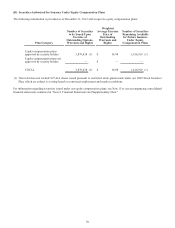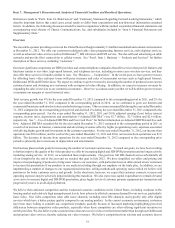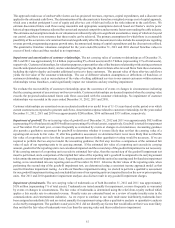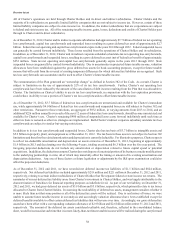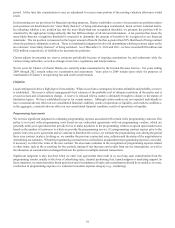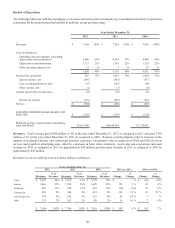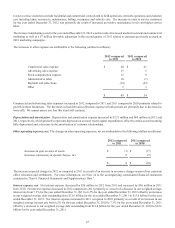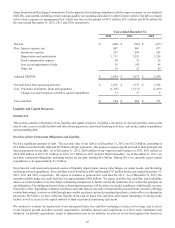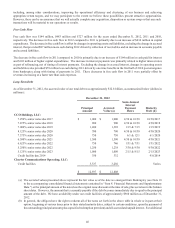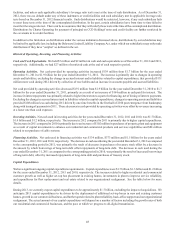Charter 2012 Annual Report Download - page 50
Download and view the complete annual report
Please find page 50 of the 2012 Charter annual report below. You can navigate through the pages in the report by either clicking on the pages listed below, or by using the keyword search tool below to find specific information within the annual report.38
Income taxes
All of Charter’s operations are held through Charter Holdco and its direct and indirect subsidiaries. Charter Holdco and the
majority of its subsidiaries are generally limited liability companies that are not subject to income tax. However, certain of these
limited liability companies are subject to state income tax. In addition, the indirect subsidiaries that are corporations are subject
to federal and state income tax. All of the remaining taxable income, gains, losses, deductions and credits of Charter Holdco pass
through to Charter and its direct subsidiaries.
As of December 31, 2012, Charter and its indirect corporate subsidiaries had approximately $7.7 billion of federal tax net operating
loss carryforwards, capital loss carryforwards and suspended losses resulting in a gross deferred tax asset of approximately $2.7
billion. Federal tax net operating and capital loss carryforwards expire in the years 2014 through 2032. Federal suspended losses
can generally be carried forward indefinitely. These losses resulted from the operations of Charter Holdco and its subsidiaries.
In addition, as of December 31, 2012, Charter and its indirect corporate subsidiaries had state tax net operating loss carryforwards,
capital loss carryforwards and suspended losses, resulting in a gross deferred tax asset (net of federal tax benefit) of approximately
$252 million. State tax net operating and capital loss carryforwards generally expire in the years 2013 through 2032. State
suspended losses can generally be carried forward indefinitely. Due to uncertainties in projected future taxable income, valuation
allowances have been established against the gross deferred tax assets for book accounting purposes, except for future taxable
income that will result from the reversal of existing temporary differences for which deferred tax liabilities are recognized. Such
tax loss carryforwards can accumulate and be used to offset Charter’s future taxable income.
The consummation of the Plan generated an “ownership change” as defined in Section 382 of the Code. As a result, Charter is
subject to limitation on the use of approximately 52% of its tax loss carryforwards. Further, Charter’s net operating loss
carryforwards have been reduced by the amount of the cancellation of debt income resulting from the Plan that was allocable to
Charter. The limitation on Charter’s ability to use its tax loss carryforwards, in conjunction with the loss expiration provisions,
could reduce its ability to use a portion of Charter’s tax loss carryforwards to offset future taxable income.
As of December 31, 2012, $3.7 billion of federal tax loss carryforwards are unrestricted and available for Charter’s immediate
use, while approximately $4.0 billion of federal tax loss carryforwards and suspended losses are still subject to Section 382 and
other restrictions. Pursuant to these restrictions, an aggregate of $932 million, in varying amounts from 2013 to 2014, and an
additional $226 million annually over each of the next 12 years of federal tax loss carryforwards, should become unrestricted and
available for Charter’s use. Charter's remaining $400 million of suspended losses carry forward indefinitely until such time as
either tax basis is restored or other tax strategies are implemented. Both Charter’s indirect corporate subsidiary and state tax loss
carryforwards are subject to similar but varying restrictions.
In addition to its tax loss carryforwards and suspended losses, Charter also has tax basis of $3.7 billion in intangible assets and
$5.2 billion in property, plant, and equipment as of December 31, 2012. The tax basis in these assets is not subject to Section 382
limitations and therefore the related amortization and depreciation is currently deductible. For illustrative purposes, Charter expects
to reflect tax-deductible amortization and depreciation on assets owned as of December 31, 2012, beginning at approximately
$1.9 billion in 2013 and decelerating over the following 4 years, totaling an estimated $6.3 billion over the five year period. The
foregoing projected deductions do not include any amortization or depreciation related to future capital spend or potential
acquisitions. In addition, the deductions assume Charter does not dispose of a material portion of its business or make modifications
to the underlying partnerships it owns, all of which may materially affect the timing or amount of its existing amortization and
depreciation deductions. Any one of these factors or future legislation or adjustments by the IRS upon examination could also
affect the projected deductions.
As of December 31, 2012 and 2011, we have recorded net deferred income tax liabilities of $1.1 billion and $824 million,
respectively. Net deferred tax liabilities included approximately $219 million and $221 million at December 31, 2012 and 2011,
respectively, relating to certain indirect subsidiaries of Charter Holdco that file separate federal or state income tax returns. The
remainder of our net deferred tax liability arose from Charter's investment in Charter Holdco, and was largely attributable to the
characterization of franchises for financial reporting purposes as indefinite-lived. As part of our net liability, on December 31,
2012 and 2011, we had gross deferred tax assets of $3.9 billion and $3.8 billion, respectively, which primarily relate to tax losses
allocated to Charter from Charter Holdco. In assessing the realizability of deferred tax assets, management considers whether it
is more likely than not that some portion or all of the deferred tax assets will be realized. Due to our history of losses, we were
unable to assume future taxable income in our analysis and accordingly valuation allowances have been established except for
deferred benefits available to offset certain deferred tax liabilities that will reverse over time. Accordingly, our gross deferred tax
assets have been offset with a corresponding valuation allowance of $2.9 billion and $2.6 billion at December 31, 2012 and 2011,
respectively. The amount of the deferred tax assets considered realizable and, therefore, reflected in the consolidated balance
sheet, would be increased at such time that it is more-likely-than-not future taxable income will be realized during the carryforward




